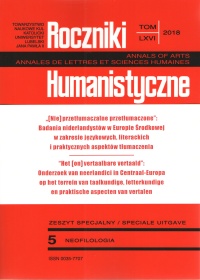A remarkable case of ‘translation plagiarism’: The series 1000 nejkrásnějších novell 1000 světových spisovatelů
Abstract
Between 1911 and 1915, publisher J.R. Vilímek introduced in his series 1000 nejkrásnějších novell 1000 světových spisovatelů [The 1000 best novellas of 1000 world authors] to Czech readers the work of several Dutch and Flemish authors – the best examples being Herman Teirlinck and Stijn Streuvels. Each collection of the series contained writers from different areas, each novella being accompanied by a short biography of the author. Among the translators we find famous names like Arnošt Procházka or Gabriele Kafková (sister of Franz Kafka). However, most Dutch short stories had already been published before, between 1910 and 1913, in the French series Les mille nouvelles nouvelles. Not only the concept but also the layout and often also Czech introductory texts are literally translated from French. In fact, the publisher committed a kind of plagiarism, especially if we consider that since the second half of the 19th century it had been good practice to translate directly from the source language.
References
Cornis-Pope, Marcel & John Neubauer. 2004. History of the Literary Cultures of East-Central Europe. Junctures and Disjunctures in the 19th and 20th Centuries Volume II. Amsterdam & Philadelphia: Johan Benjamins.
Daems, Luc. 2000. ‘Vlaamse en Nederlandse novellen in vroege Franse vertaling van Pieter van der Meer de Walcheren inzonderheid Streuvels’ Doodendans of La Ronde de la Mort.’ Verslagen en Mededelingen van de Koninklijke Academie voor Nederlandse taal- en letterkunde 110 (1): 107–158.
Engelbrecht, Wilken. 2013. ‘A Moravian Picture of Dutch Literature.’ In Jitka Zehnalová, Ondřej Molnár & Michal Kubánek (eds.). Tradition and Trends in Trans-Language Communication. Proceedings of the International Conference Translation and Interpreting Forum Olomouc 2012 (Olomouc Modern Language Series 2), 215–228. Olomouc: Palacký University.
Engelbrecht, Wilken. 2016a. ‘De Leeuw van Vlaenderen in het Tsjechisch. Waarom zo laat en waarom driemaal?’ Internationale Neerlandistiek 54, 3: 169–188. DOI: 10.5117/IN 2016.3.ENGE.
Engelbrecht, Wilken. 2016b. ‘Het ontstaan van de idee ‘Nederlandstalige literatuur’ in Tsjechië’. Werkwinkel. Journal for Low Countries and South African Studies 11, 1: 73–94.
Engelbrecht, Wilken. 2017. ‘Persoonlijke contacten in de vooroorlogse receptie van Nederlandstalige literatuur in Tsjechische vertaling.’ Neerlandica Wratislaviensia 27: 141–154.
Engelbrecht, Wilken, & Zuzana Vaidová. 2016. ‘“De grootste hedendaagse auteur in Europa bekend...” Louis Couperus in Tsjechië’. Arabesken. Tijdschrift van het Louis Couperus Genootschap 24, 48: 4–14.
Huffel, Albert J. van, 1939. Nederlandsche schrijvers in vertaling (van Marcellus Emants tot Jan Eekhout). Proeve van een bibliographie. Leiden: E.J. Brill.
Kosterka, Ladislav. 1932. Bibliografie česko-skandinávsko-nizozemská. (Seznam českých překladů z dánštiny, islandštiny, norštiny, švédštiny, holandštiny a vlámštiny). Praha: Nákladem obce pražské.
Rottensteiner, Franz. 1967. Das Literarische Bureau: Pressepolitik, Organisation und Wirksamkeit. Diss. Wien.
Schwendiger, Christian. 2011. Kriegspropaganda in der Habsburgermonarchie zur Zeit des Ersten Weltkriegs. Wien: Diplomica Verlag.
Urban, Otto, & Luboš Merhaut (1995). Moderní revue 1894–1925. Praha: Torst.
Vliet, Hendricus T.M. van. 1987. Louis Couperus en L.J. Veen: bloemlezing uit hun correspondentie. Utrecht & Antwerpen: Veen.
Zach, Aleš. 1996. Stopami pražských nakladatelských domů: procházka mizející paměti českých kulturních dějin. Praha: Thyrsus.
Zach, Aleš. 2008. ‘Jos. R. Vilímek.’ In Luboš Merhaut (ed.). Lexikon české literatury. Osobnosti, díla, instituce. 4 S-Ž, II U-Ž, dodatky A-Ř, 1339–1350. Praha: Academia.
Copyright (c) 2018 Roczniki Humanistyczne

This work is licensed under a Creative Commons Attribution-NonCommercial-NoDerivatives 4.0 International License.





